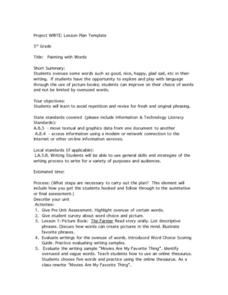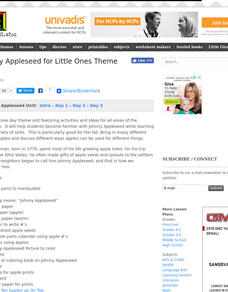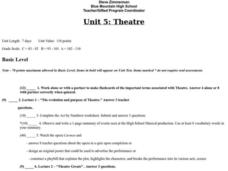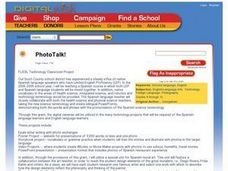Curated OER
Postcards to Rembrandt
Students "read" a work of art and infer meaning by analyzing its elements of art and principles of design. They practice creative writing by composing a postcard to an imaginary person.
Curated OER
Great North
Students use maps to locate the Arctic Circle, the North Pole and Northern Europe. They draw and label countries within the Arctic Cirlce and identify the groups of people who live there. They also watch and answer questions about the...
Curated OER
Wild Swans
Students, watching the movie, "Wild Swans," explore a writer's journey of discovery about her mother, grandmother, and herself. They also study the Chinese culture and history of the last 50 years.
Curated OER
Painting with Words
Fifth graders discuss words that are over used in their writing such as good, nice, happy, glad sad, etc. they complete a survey about word choice then hear a story and discuss descriptive phrases used in the story and how they help to...
Curated OER
Charlie and the Chocolate Factory
Fourth graders research and write an author report on Roald Dahl, including books written by him, birthplace, family life, and other information on his writing. Students read aloud chapters in the book. Students create a newspaper...
Curated OER
Johnny Appleseed Theme Unit: Day 1
Students participate in a variety of activities surrounding a thematic unit on apples and Johnny Appleseed.
Curated OER
Project Whistlestop
Students conduct research and present a part of Kansas City history to the class. They develop questions and ideas to initiate and refine research. They use technological tools and other resources to locate, select and organize information.
Curated OER
To Kill a Mockingbird
Young scholars participate in a layered curriculum unit in order to give them opportunities to master objectives. Students pick the activities and this allows a differentiated lesson to occur with many opportunities for assessment.
Curated OER
Theatre
Students identify and create flashcards of important key terms as related to theatre. Students observe and write a 1-page summary of events seen at the High School Musical production using at least 8 vocabulary words in your summary....
Curated OER
Ad Awareness from Admongo.gov
Students explore mass media by completing worksheets in class. In this consumerism activity, students discuss the meaning behind advertisements and how they are used in television, the Internet and print. Students analyze a group of ads...
Curated OER
Alfred Hitchcock and David O. Selznick
Students compare/contrast the Hollywood film industry of the 30s and 40s with Hollywood today. They watch a video on David O. Selznick and Alfred Hitchcock, conduct Internet research, and create a poster to present their findings.
Curated OER
High-Tech Heaven?
Young scholars read and discuss, "Post-Christmas Comes a Geek's Gizmo-Rama" by David Pogue. They consider how technologies they use impact their lives.
Curated OER
Digging through the mess to find the treasure
Students summarize a text selection of their choice. After a brief, written demonstration of summarizing, students read a selection of their choice. With a partner, they summarize what they have read in their own words and create a...
Curated OER
Civil Rights and the ADA
Middle schoolers examine and discuss the 14th and 15th amentments, and evaluate the agendas of Americans from underrepresented groups in the quest for civil rights. They conduct Internet research and create essays or posters regarding...
Curated OER
Photo Talk!
Students communicate with Epals. They write letters with photo exchanges
and create a website for presentations of 3,000 words or less and one photo. They
tell their life stories and illustrate with photos in the target language.
V
Channel Islands Film
Restoration Channel Islands Debate
Introduce learners to the debate format with an activity that uses the National Park Service's controversial Channel Islands restoration program as a topic. Class members learn how to generate provocative debate questions, how to prepare...
Curated OER
Why We Communicate
Students identify the three common reasons for communication: information, persuasion, and entertainment. They create media messages for different purposes and develop a purpose of message shapes and how it helps shape the message.



















